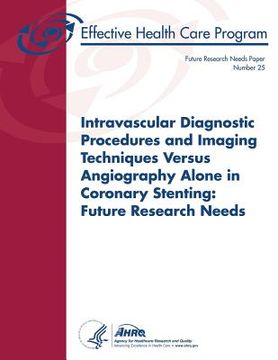Intravascular Diagnostic Procedures and Imaging Techniques Versus Angiography Alone in Coronary Stenting: Future Research Needs: Future Research Needs (en Inglés)
Reseña del libro "Intravascular Diagnostic Procedures and Imaging Techniques Versus Angiography Alone in Coronary Stenting: Future Research Needs: Future Research Needs (en Inglés)"
Coronary artery disease (CAD), is a narrowing (stenosis) of one or more of the epicardial coronary arteries. It is most commonly due to the buildup of plaque (atherosclerosis), which impedes the ability of these blood vessels to deliver oxygenated blood to the heart muscle (myocardium). Revascularization of the stenotic vessel either by dilatation using a balloon (also known as angioplasty) or by using a bypass venous graft (also known as coronary bypass) are the most common methods to restore blood supply. Percutaneous coronary intervention (PCI) or angioplasty with stent deployment is currently the most commonly performed revascularization procedure for CAD. PCI has traditionally been based on qualitative and quantitative coronary angiography (visual inspection of the radiocontrast lumenogram and computer-based quantification, respectively), an imaging technique for visualizing the interior of blood vessels. While angiography is the standard technique for anatomic visualization of coronary arteries, it is not without limitations as it does not provide information about what is causing the narrowing or whether the narrowing seriously impedes blood flow. Several adjunctive intravascular diagnostic procedures and imaging techniques have been developed for the purpose of providing more detailed anatomic and hemodynamic information about lesions in coronary arteries. However, whether this additional information improves patient outcomes and whether this improvement outweighs any risks introduced by the additional procedure needs to be considered. Using criteria based on the AHRQ CER Methods Guide, we assessed the strength of evidence for major comparisons of interest, as follows: - There is a moderate strength of evidence (drawn from one randomized controlled trial [RCT] and one nonrandomized study) that the adjunctive use of FFR during stenting, as compared with angiography alone, to decide whether an intermediate coronary lesion (50 to 70% stenosis) requires stenting, can confer a lower risk of composite endpoint of death or myocardial infarction (MI) or of major adverse cardiac event (MACE), decrease procedural costs, and lead to fewer stent implantations. However, these FFR studies also included patients with low risk lesions and lower grades of angina, and excluded left main coronary artery disease and acute MI. - There is a moderate strength of evidence (drawn from 9 RCTs and 22 nonrandomized studies) that supports no significant difference in mortality and MI, but a significant reduction in restenosis and repeat revascularizations with IVUS-guided stenting compared with stent placement guided by angiography alone. This significant reduction was observed in RCTs, but not observed in nonrandomized comparative studies. Notably, most of the RCTs were conducted before 2000 using previous generation bare-metal stents. - There is insufficient evidence concerning the use of any intravascular diagnostic techniques immediately after PCI to evaluate the success of stent placement as compared with angiography, or for direct comparisons between intravascular diagnostic techniques. - There is a moderate strength of evidence (on the basis of one large-sample-size nonrandomized study) that sex, diabetes mellitus status, lesion length and reference diameter, and interaction with IVUS- and angiography-guided stent placement did not show any significant association with individual components of death or MI or the composite outcome of MACE. - There is insufficient evidence to evaluate the comparative effect of techniques other than FFR and IVUS on outcomes. The present report describes the development of a stakeholder-prioritized list of research needs for that topic, along with a measured consideration of the advantages and disadvantages of various potential research designs, in order to help researchers and funders develop future research proposals or solicitations.

